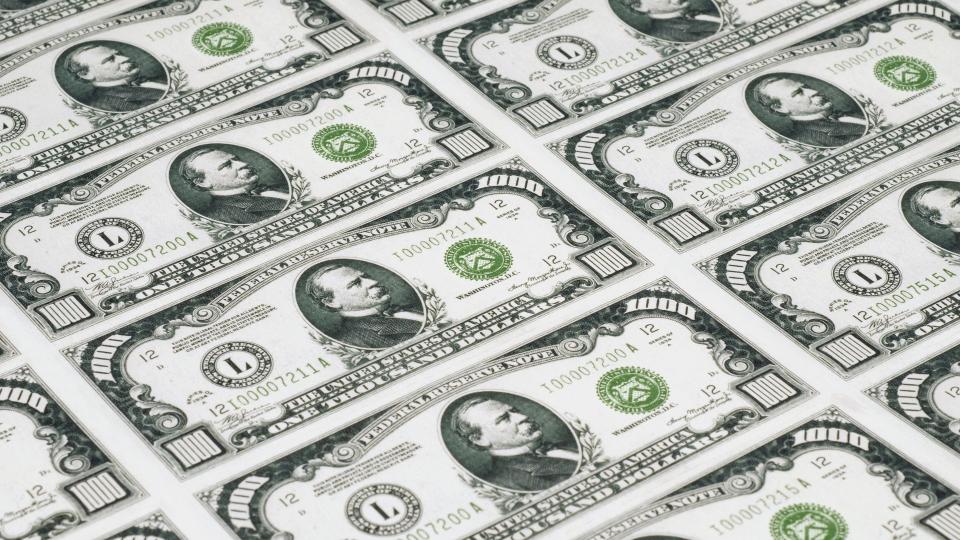5 Discontinued American Bills Worth More Than Face Value

Although the term “three dollar bill” is widely used to denote something phony, the U.S. government was actually thinking of producing one in 1862. It never did, but that year it started printing the $2 bill, which is still printed today.
See: Check Your $2 Bills — They Could Be Worth Thousands
Find: $2,000 Quarter? Check Your Pockets Before You Use This 2004 Coin
There are around 1.5 billion $2 notes in circulation as of Dec. 31, 2022, making it the rarest currency denomination in the U.S. today, according to the Federal Reserve. The $2 bill has not been officially discontinued.
$2 bills are not truly uncommon, but certain varieties can fetch anywhere from $3 to $2,500 at auction or from a collector. However, there are larger denomination bills that, while no longer in circulation, are still legal tender and highly valuable.
On July 14, 1969, the Department of the Treasury and the Federal Reserve System announced that currency notes in denominations of $500, $1,000, $5,000 and $10,000 would be discontinued immediately due to lack of use.
These high-denomination bills were primarily used for large transactions between banks, but their discontinuation was also driven by concerns about money laundering and tax evasion.
However, they are out there. You’ll find $500, $1,000, $5,000 and $10,000 notes in the hands of collectors and dealers. But 1969 wasn’t that long ago, so if you happen to find an oddball bill with a strange president’s face on it, don’t be quick to dismiss it as a fake.
Here are five discontinued American bills, or currency denominations, that are no longer in circulation:
$500 Bill
A few versions of the $500 bill were printed over the years and was last printed in 1945. Featuring a portrait of President William McKinley on the front, this bill was officially discontinued in 1969, along with other high-denomination bills, making it scarce. According to Collectibles & Currency, 1928 series bills are more collectible than 1934 series, but depending on the condition, an old $500 bill should net you anywhere between $800 and $4,000. $500 bills printed in 1918 have the likeness of John Marshall, the fourth U.S. Chief Justice of the Supreme Court, on them.
Also: If You Find a Lincoln Penny With This Distinctive Mark, It Could Be Worth up to $60,000
$1,000 Bill
The first $1,000 bill was printed in 1861, during the American Civil War, but it wasn’t until the 1920s that it became more widely used. The $1,000 bill first featured Founding Father Alexander Hamilton on the front but were later replaced with that of President Grover Cleveland McKinley. Although Old Money Prices claims most are worth an average of $1,650, some $1,000 bills have been sold for over $100,000.
$5,000 Bill
The $5,000 bill featured President James Madison and was last printed in 1945. Like the $500 and $1,000 bills, it was discontinued in 1969. Like $500 bills, 1928 $5,000 bills are scarcer than 1934s and, according to Old Currency Values, there are only under two dozen 1928s known to exist. Even the A $5,000 bill can be purchased between for between at least $15,000 and $25,000, per U.S. Currency Auctions, depending on its condition and grading, seal and series.
$10,000 Bill
As Barron’s Penta recently reported, an uncirculated 1934 $10,000 note was sold at auction for $480,000 in California. “Large-denomination notes always have drawn the interest of collectors of all levels,” Dustin Johnston, vice president of currency at Heritage Auctions, said in a statement. The $10,000 bill featured Salmon P. Chase — who served as Secretary of the Treasury under Abraham Lincoln and served as chief justice of the Supreme Court — and was last printed in 1945. It was discontinued in 1969 for similar reasons as the other high-denomination bills and commands large bids at auction. In fact, it’s illegal for a collector to hold a $100,00 bill.
$100,000 Bill
The highest denomination bill ever printed by the Bureau of Engraving and Printing, the $100,000 bill was a Gold Certificate featuring President Woodrow Wilson and was only used as an accounting device for transactions between branches of the Federal Reserve. Printed in 1934, the note was never in wide circulation and while fascinating and historically significant, does not possess a current monetary value in terms of face value or legal tender.
More From GOBankingRates
This article originally appeared on GOBankingRates.com: 5 Discontinued American Bills Worth More Than Face Value

 Yahoo Finance
Yahoo Finance 